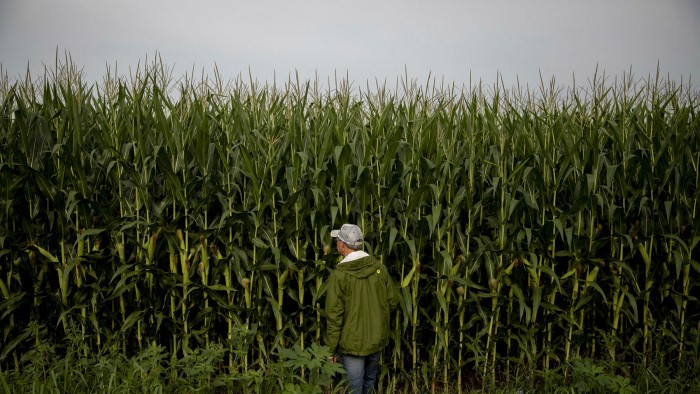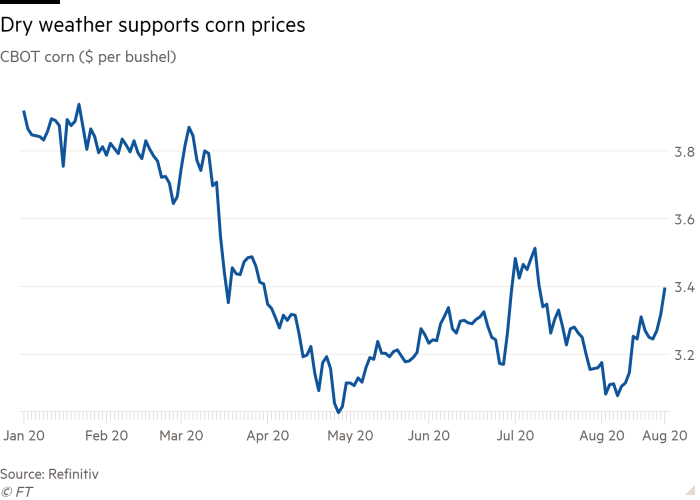Low rainfall in US Midwest drives corn prices higher

Roula Khalaf, Editor of the FT, selects her favourite stories in this weekly newsletter.
Worries about a lack of rainfall this month in the US Midwest have lifted corn prices, with data from the US Department of Agriculture pointing to deteriorating crop conditions.
Benchmark corn prices are up almost 4 per cent since the start of the week at $3.39¼ a bushel, and have gained 9 per cent over the past two weeks.
Prices had already received a boost after crops were damaged during a storm on August 10 that hit Iowa, a key corn-growing state. The latest concern, however, has been the low rainfall in the US corn belt throughout August, a situation that is expected to continue for the rest of the week.
“[The] forecast remains hot and sweltering for the balance of the week,” said Matt Ammerman at commodity brokers Stone X. He added that while conditions were set to become cooler by the weekend, the lack of rain was likely to lead to a further decline in crop conditions.
Farmers have been hoping that Hurricane Laura might bring in the much-needed rain in the Midwest. However, the immediate forecast for the region is that it will remain dry. “It’s a non-issue,” said Mr Ammerman.
Much of the corn crop has nearly reached maturity, but the plants still need moisture for the final stages. With parts of the Midwest receiving only 15 to 40 per cent of normal rainfall, the crop will need to rely on existing soil moisture, which was likely to affect yields, said Stone X.

According to the USDA’s latest weekly crop progress report, the percentage of corn crops classed as good to excellent dropped to 64 per cent from 69 per cent in the previous week. In Iowa, it fell to 50 per cent from 59 per cent, reflecting the effects of the storm.
The weather concerns come as meteorological agencies in the US and Australia have recently raised the likelihood of a La Niña weather phenomenon occurring later this year.
A La Niña, caused by the cooling of the tropical Pacific Ocean, typically brings droughts to the US Midwest and California. Commodity data firm Gro Intelligence said that while its full impact could not be predicted, “history has shown that the consequences of such climate events can be far-reaching”.
During the 2012 La Niña, the US suffered its worst drought in 50 years and grain and soyabean prices surged. However, the last La Niña in 2017 was weak and had little impact on commodity markets.
La Niña also brings lack of rain in southern Brazil and central Argentina, and farmers and traders in Argentina are bracing for a drought because the country has already been experiencing lower than average rains.
Meanwhile, uncertainty over the demand outlook continues because of the coronavirus pandemic and the US-China trade war.
So far, active buying of grains and soyabeans by China has been supporting prices despite the geopolitical tensions. Beijing has increased its purchases of US agricultural crops considerably in recent weeks, which will also be reflected after some delay in US export figures, said Commerzbank.
Soyabean prices in Chicago have risen 3.7 per cent over the past two weeks to $9.11¼ a bushel while wheat is up 7.3 per cent to $5.31 1/2.
Comments